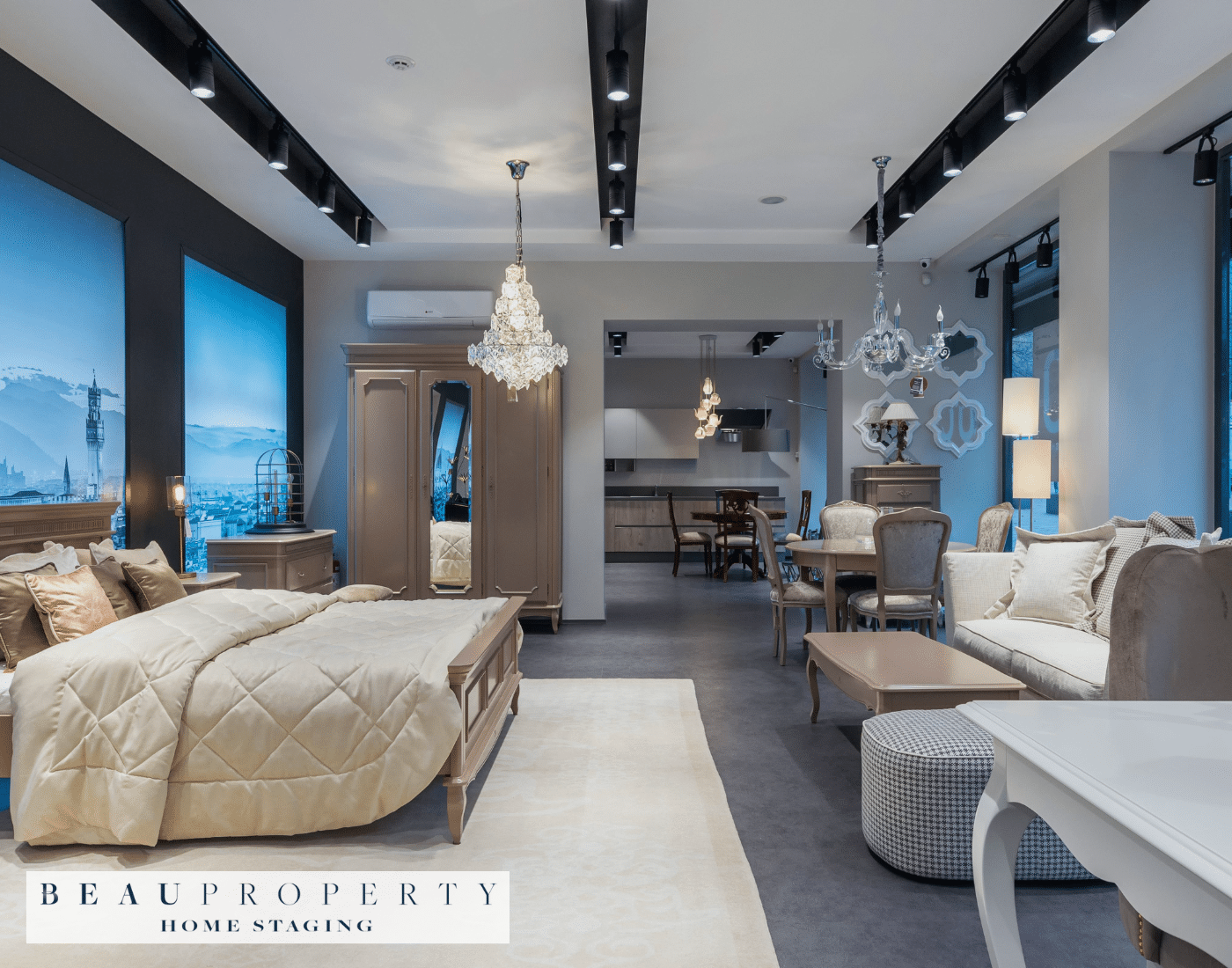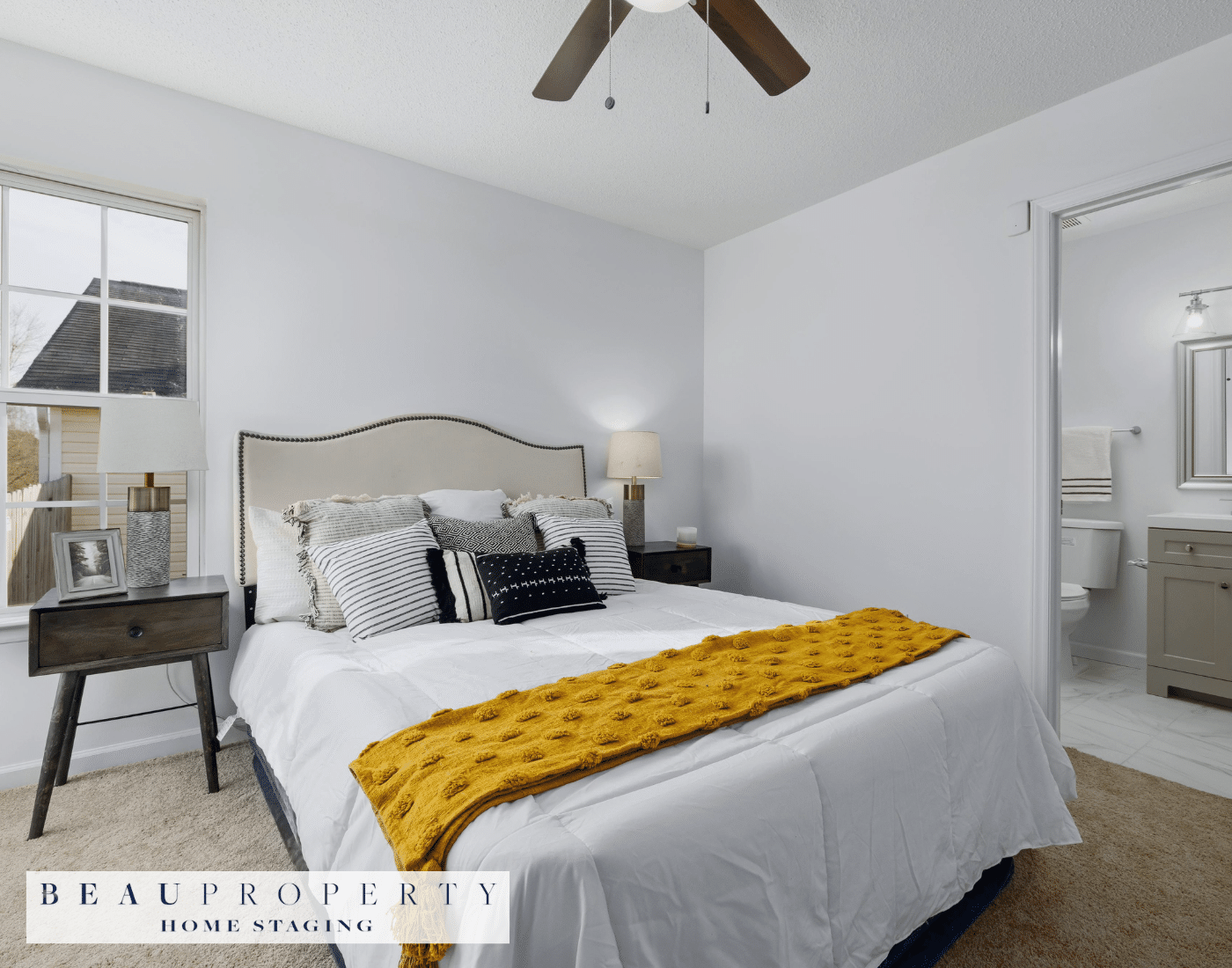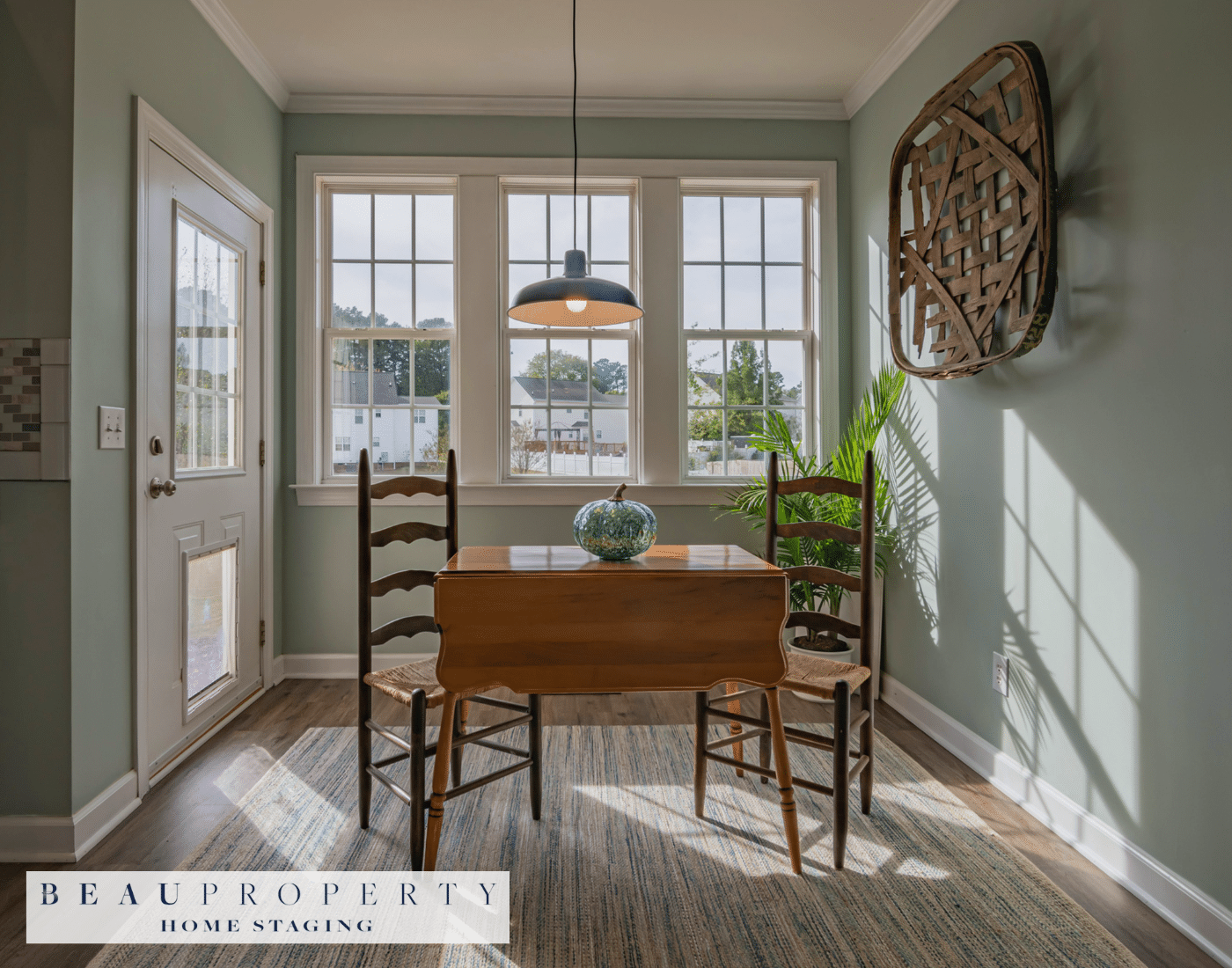Understanding Home Staging
Definition of Home Staging
Home staging is a strategic process aimed at preparing a private residence for the real estate market. This involves redecorating, rearranging furniture, cleaning, and applying aesthetic strategies to present the home in the best possible light.
Goals of Home Staging
The primary goal of home staging is to enhance the appeal of a property to the widest range of potential buyers. By creating an inviting environment, staging allows prospective buyers to envision themselves living in the space. This approach, as explained by Beau Property Staging, involves creating a clean, uncluttered palette that is free from personal artefacts, which might otherwise impede a buyer’s imagination.
Importance in the Real Estate Market
Staging plays a crucial role in the real estate market by boosting a property’s selling potential. It has been observed that staged homes can sell more quickly and often at a higher price than non-staged ones. Professional staging can also bring an impressive return on investment, increasing the home’s dollar value by 1% to 10%. Additionally, it helps highlight the home’s best features, minimising any negative aspects, thus fostering a positive first impression among buyers.
The next aspect in enhancing your property’s allure involves a thorough assessment of your space, identifying its strengths and weaknesses to leverage its most attractive features.
Assessing Your Space
Identifying Strengths and Weaknesses of Your Home
Before staging a home, it is vital to assess its unique features. Identifying strengths allows for highlighting what makes your property stand out. As Beau Property Staging recommends, consider elements such as a spacious kitchen, natural light, or architectural details. Conversely, understanding any weaknesses—such as cramped spaces or outdated fixtures—that may need improvement or camouflage is equally important. Recognising these aspects will pave the way for effective staging.
Understanding Buyer Perspectives
Buyers often perceive a home’s value through both its aesthetic appeal and functional potential. They envision their lives within the space, making emotional and cognitive connections that influence their decisions. By understanding common buyer preferences, such as open layouts and neutral colours, you can tailor your staging efforts to align with these expectations. Factors such as neighbourhood reputation and proximity to amenities also play a significant role in shaping buyer opinions.
The 3-Foot 5-Foot Rule in Staging
The 3-foot 5-foot rule serves as a practical guideline in home staging. From three feet away, potential buyers focus on details like décor and cleanliness. Items within this range should be spotless and well-presented. At five feet, buyers take in the overall room design. The colours, arrangement, and flow become more apparent. This rule aids in ensuring your home makes a positive impression at every glance.
By thoroughly assessing your space, you can effectively stage your home to resonate with potential buyers, increasing the likelihood of a successful sale. As you delve into the next steps of staging, remember to keep the buyer’s perspective at the forefront.
Decluttering and Depersonalising

Importance of Minimising Personal Items
Minimising personal items is crucial in home staging as it allows potential buyers to envision the property as their future home. Personal photographs, mementos, and unique decor can distract buyers, making it harder for them to imagine their lives in the space. Creating a blank canvas encourages buyers to mentally place their own belongings in the home, enhancing appeal and emotional connection.
Strategies for Effective Decluttering
A systematic approach is essential for successful decluttering. Begin by tackling one room at a time to avoid feeling overwhelmed. Use methods like the Core 4 strategy, which involves clearing out, categorising, cutting out unnecessary items, and containing what’s left. Sorting items into categories—keep, donate, sell, or dispose—helps streamline the process and reduces sentimental attachment. Additionally, opting for neutral artwork or decor can replace personal items, keeping the space inviting yet impersonal.
- Start small and choose one area at a time.
- Use the Four Box Method: Trash, Storage, Put Away, Give Away/Sell.
Creating a Neutral Space for Potential Buyers
Neutralising a space is pivotal in making it universally appealing. This involves removing personal tastes and opting for neutral colours and designs. As highlighted by Beau Property Staging, neutral tones in paint, furniture, and accessories can make the property more welcoming and spacious. It’s also beneficial to reduce clutter to increase the perceived size of rooms, making them appear more open and accessible.
Transitioning from decluttering and depersonalising, focus shifts to enhancing first impressions—fundamental to capturing buyer interest from the outset.
Enhancing Curb Appeal
First Impressions and Their Impact
First impressions are crucial in real estate, setting the tone for potential buyers before they even step inside. A home’s exterior, visible at first glance, plays a pivotal role in shaping these initial perceptions. Prospective buyers form opinions within seconds, often using curb appeal to gauge the property’s overall worth. Homes with strong curb appeal typically sell faster and at higher prices, underscoring the importance of a well-maintained exterior.
Quick and Affordable Exterior Improvements
Improving curb appeal doesn’t require a significant financial investment. Small, cost-effective enhancements can make a substantial difference. Painting the front door in a bold, coordinating colour is a simple yet effective upgrade. Adding or updating house numbers and installing matching light fixtures can enhance the entryway’s appeal. Pressure washing the driveway and cleaning the windows can also revitalise the property’s look.
For those looking to invest less than £100, consider installing flower boxes, hanging baskets, or a new mailbox. These additions can inject personality and warmth into the exterior.
Landscaping Tips for Maximum Appeal
Landscaping is a key component of curb appeal and can significantly impact perceived property value. A well-manicured lawn serves as the foundation of an attractive landscape. Planting trees and maintaining healthy, vibrant plants can enhance the garden’s visual appeal. Fast-growing trees or colourful annuals and perennials can be excellent choices for an inviting appearance.
Defining garden borders with mulch or stones and incorporating accent lighting can add depth and interest. These features guide the eye and highlight the property’s best attributes, creating a cohesive, polished look.
By focusing on these curb appeal strategies, sellers can improve their home’s marketability, setting a positive foundation for potential buyers. As Beau Property Staging emphasises, enhancing the exterior appearance is just as crucial as interior staging, ensuring the property makes a strong first impression.
Room-by-Room Staging Techniques
Staging your home effectively involves transforming key areas like the living room, kitchen, and bedrooms to highlight their best features. These spaces hold significant influence over potential buyers, making their presentation crucial.
Living Room
Furniture Arrangement
Rethink furniture placement by grouping sofas and chairs into conversational sets rather than lining them against walls. This not only encourages interaction but also makes the room appear more spacious and welcoming. As Beau Property Staging advises, ensuring there’s clear traffic flow allows buyers to navigate the space effortlessly. Remember, less is more; consider removing unnecessary furniture to avoid overcrowding and to showcase the full potential of the room.
Highlight Features
Identify and accentuate the room’s focal points, such as a fireplace or large windows. Use decor sparingly to draw attention to these features. A fresh coat of neutral paint can enhance this effect by creating a bright, open atmosphere.
Kitchen
Decluttering and Organisation
A clutter-free kitchen is pivotal. Clear countertops and cabinets, removing non-essential items to showcase ample space. Consider minor upgrades, like updating light fixtures or cabinet hardware, to modernise the appearance.
Showcasing Best Aspects
Highlight the kitchen’s strengths, whether that’s spacious countertops or modern appliances. Use a light, cohesive colour palette to create a welcoming environment. This approach helps potential buyers imagine themselves cooking and entertaining in the space.
Bedrooms
Bed Arrangement and Decor
Select an appropriately sized bed for the room to maintain balance. Neutral bedding can add a touch of elegance while giving the space a fresh feeling. Incorporate subtle decorative elements like an area rug or artwork, but avoid overcrowding.
Creating Space
Ensure closets are organised and not crammed, as spacious storage is often a priority for buyers. Keep window treatments minimal to allow natural light to enhance the space’s warmth and appeal.
Optimising these rooms through thoughtful staging can significantly influence a buyer’s perception, making your home more attractive on the market. As we further explore staging techniques, the importance of proper lighting and colour strategy will come into focus.
Lighting and Colour Strategies
Importance of Proper Lighting in Staging
Lighting plays a critical role in home staging, enhancing the overall ambiance and ensuring your property looks its best. The right lighting can make spaces appear larger and more inviting. Expertly placed lighting highlights architectural features and draws attention to standout elements like artwork or scenic views, creating focal points that captivate potential buyers. A well-lit environment can evoke emotional responses, making a house feel like a welcoming home.
Types and Techniques
To achieve effective lighting, consider employing layers—ambient, task, and accent lighting. Ambient lighting provides overall illumination, while task lighting focuses on specific activities. Accent lighting highlights particular areas of interest. Natural light should be maximised wherever possible, as it enhances the space’s warmth and appeal.
Choosing the Right Color Palette
The colour palette in staging significantly influences a buyer’s perception. Warm neutrals like beige and grey are highly effective, as they create a versatile and inviting backdrop. These colours work well with various styles, helping potential buyers envision personalising the space.
Using Colour Psychology
Colour psychology informs how shades affect mood and perception. Warm colours such as red, orange, and yellow evoke feelings of warmth and energy, making them ideal for social spaces like living rooms and kitchens. As Beau Property Staging suggests, strategically using pops of warm hues through artwork or cushions can enhance a space’s vibrancy without overwhelming the senses, creating a balanced and inviting atmosphere.
Using Colour to Create Warmth and Appeal
Creating a welcoming atmosphere involves selecting colours that resonate with comfort and warmth. Warm paints from the red, yellow, and orange families are perfect for creating cosy living areas. These colours are associated with happiness and optimism, appealing to buyers seeking a homely feel. Accessories like rugs and pillows can be used to introduce these colours subtly, ensuring they complement rather than clash with existing decor.
By carefully balancing lighting and colour, your home can become a compelling canvas that attracts potential buyers, setting the stage for successful viewings and ultimately, a seamless sale.
Budget-Friendly Staging Tips
DIY Staging Techniques
Transforming your home can be cost-effective with a few strategic DIY staging techniques. Begin by rearranging existing furniture to enhance space and flow. Use a minimalistic approach, focusing on essential pieces to create a clean and open atmosphere. Repurpose what you have: consider turning an old door into a headboard or using baskets as side tables. These creative solutions can add unique charm without the expense.
Low-Cost Updates with High Impact
Implementing affordable updates can drastically change the look of your home. Fresh paint is a powerful yet budget-friendly option. Opt for neutral tones to appeal to a broader audience, but don’t hesitate to add a pop of colour to highlight architectural features. Instead of replacing outdated furniture, use slipcovers to give them a fresh look. Also, update small fixtures like door knobs and light switches for a modern feel.
Repurposing Existing Items for Staging
Clever repurposing of household items can enhance your staging without additional cost. Old mirrors can serve as trays, and a tablecloth can be transformed into drapery panels. Utilise items creatively to demonstrate the full potential of each space. Remember, even simple decor changes can make a significant impact.
As you incorporate these budget-friendly strategies, remember that creativity and resourcefulness are key. Maximising the potential of your space doesn’t require a hefty investment, just an imaginative approach. Beau Property Staging emphasises that embracing these tips can effectively showcase your home’s best qualities, setting the stage for potential buyers’ imaginations.
Professional Staging vs. DIY
Pros and Cons of Hiring a Professional Stager
Hiring a professional stager can be a transformative step in preparing your home for sale. Professional stagers bring a wealth of expertise and have access to resources like furniture rentals and impressive artwork, which can significantly enhance the home’s appeal. Their skill in understanding buyer behaviour and real estate trends allows them to stage a home strategically, potentially leading to a higher selling price and faster sales.
However, there are disadvantages. The costs can be substantial, ranging from $1,500 to $4,000 on average, depending on the size of the home and whether it is vacant or occupied. Additionally, there are ancillary costs such as storing personal items and maintaining the property in its staged state.
Costs Associated with Professional Staging
Professional staging involves several costs, including an initial design consultation, which is typically between $300 and $600. Renting furniture and decor for staging can cost $500 to $600 per month per room. These expenses add up, especially for larger homes, making it essential to consider the potential return on investment.
When to Consider Professional Help
Deciding whether to hire a professional depends on multiple factors. If your home has a complex layout or you lack the time and expertise to manage staging effectively, Beau Property Staging can provide invaluable assistance. A professional stager ensures that the home resonates well with the intended buyer demographic. Additionally, in competitive market conditions, professional staging can offer an edge over other listings, helping your property stand out.
While professional staging can be a significant investment, its potential to expedite sales and increase home value should not be underestimated. As we explore virtual staging options, the decision-making process will gain another dimension.
Virtual Staging Options
Introduction to Virtual Staging Technology
Virtual staging is revolutionising the real estate industry by providing a cost-effective way to enhance property images with digitally added furniture and decor. This specialised computer-assisted design (CAD) process elevates the visibility and appeal of listings, capturing buyer interest through highly realistic and attractive visuals. By simply enhancing photos of empty rooms, virtual staging creates a polished look that draws potential buyers’ attention in today’s digital marketplace.
Benefits and Limitations of Virtual Staging
Virtual staging offers numerous advantages, particularly in boosting a property’s online presence. It saves time, offers a wide range of customisation options, and is significantly more affordable than traditional staging methods. Buyers are often drawn to virtually staged images as these provide a comprehensive view of the space’s potential.
However, there are limitations to consider. Virtual staging cannot replicate the experience of physically being in a staged environment, which may lead to dissatisfaction if online representations diverge from reality. Therefore, it is essential to manage expectations and disclose to buyers that they are viewing virtually enhanced images.
Cost Comparisons with Traditional Staging
The cost-effectiveness of virtual staging is one of its most compelling features. Traditional staging can be expensive, often requiring physical furniture rentals, movers, and storage fees. In contrast, virtual staging requires only digital modifications, with prices typically ranging from $72 to $360 per photograph, depending on the complexity and provider chosen.
The significant reduction in costs allows sellers to maximise their returns without compromising on aesthetics. This affordability, paired with quick turnaround times, makes virtual staging an appealing option for sellers looking to make an impactful impression in a competitive market.
As we move forward, understanding these nuances of staging aids in crafting strategic approaches to property presentation, an essential step in today’s real estate landscape. Beau Property Staging provides insights into how tailored staging techniques can elevate a property’s appeal, ensuring it stands out in a competitive market.
Measuring the Impact of Staging
Influence on Sale Prices and Market Time
Home staging has become an essential tool in real estate, demonstrating significant influence on both the sale prices of homes and the duration they remain on the market. Staged homes not only sell 88% faster but also at prices 20% higher than those of non-staged homes. This evidence highlights the necessity and benefits of home staging in ensuring a property’s market readiness.
Buyers tend to offer between 1% to 5% more for staged properties as reported by seller’s agents, while some accounts note increases ranging from 5% to 23% over the listing price. Additionally, staging has been shown to cut the average time a home spends on the market by 73%.
Return on Investment (ROI)
Staging represents not just an aesthetic enhancement but a strategic investment. The return on investment from staging can be remarkably high, with reported ROIs ranging from 158% to as much as 1194%. Even modest investments, such as 1.3% of a property’s value in staging, can yield returns with a 7.1% average increase above the listing price.
Gathering Feedback and Adjustments
Feedback collection is a crucial aspect of staging success, benefiting from diverse methods to gauge effectiveness. Surveys, interviews, and informal reviews from buyers and agents allow for tailored adjustments. As Beau Property Staging suggests, online surveys offer efficiency and wide reach for collecting valuable insights. These strategies help identify opportunities to further enhance staging efforts, ensuring that each home makes the most impactful impression.
This comprehensive understanding of the effects and benefits of staging paves the way for exploring other innovative approaches to real estate enhancements.








